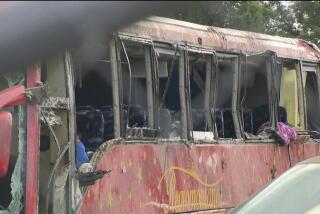‘Virtual’ Crash Aims to Save Lives at Railroad Crossings
- Share via
WASHINGTON — It’s quiet. Nothing moves as the inside of a school bus fills the TV screen for a moment. BANG! The bus lurches sickeningly and rips open as a train engine slams into it from the side.
The film: a training video for school bus drivers.
If that scene--and the same crash shot from other angles--doesn’t scare them, nothing will.
A massive locomotive loomed in the background at Washington’s busy Union Station recently as a coalition of government, business and private safety officials unveiled the new training program.
While the goal is to prevent such accidents in the future, much of the talk was of the day a year ago, Oct. 25, 1995, when a school bus and train crashed in Fox River Grove, Ill.
Stopping at a traffic light after crossing a railroad track, the substitute bus driver was unaware that the rear of the vehicle extended over the track. Moments later it was too late: Seven youngsters died in the crash.
“It was tragic. It was needless. It could have been prevented. That’s why we are here today,” Transportation Secretary Federico Pena told the group.
Developed by Operation Lifesaver, a national group dedicated to preventing accidents at railroad crossings, the new training program was financed by $70,000 from Pena’s department and is being distributed nationwide.
The program is designed to heighten drivers’ awareness of railroad crossings, in particular by helping them recognize dangerous intersections like the one in Illinois, said Don LaFord of Parkton, Md., an Operation Lifesaver activist.
Barbara Belk of Suitland, Md., said 18 intersections in her state already have been identified as posing dangers similar to the one in Illinois, where the short distance between the tracks and the stoplight increased the hazard for long vehicles like school buses.
LaFord and Belk, an Operation Lifesaver coordinator, said they are adding the identified dangerous areas to the training effort in Maryland to teach drivers who go on field trips away from normal routes.
Pena said his department also is developing new standards for crossing designs with the goal of eliminating such hazards.
In the meantime, improved driver training is expected to help the 24 million children who ride school buses daily.
While school bus accidents are rare, grade-crossing accidents involving trains and other vehicles have long been a problem that safety officials have struggled to overcome.
Pena said public education campaigns seem to be paying off. He said 201 deaths occurred in grade-crossing accidents in the first half of this year, down from 309 in the corresponding period of 1995.
More to Read
Sign up for Essential California
The most important California stories and recommendations in your inbox every morning.
You may occasionally receive promotional content from the Los Angeles Times.












